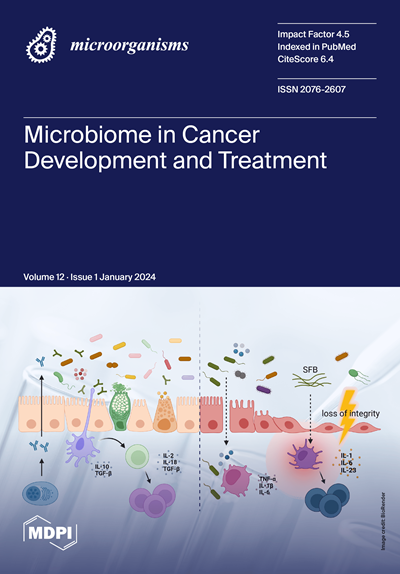Synthesis of Tellurium Nanoparticles Using Moringa oleifera Extract, and Their Antibacterial and Antibiofilm Effects against Bacterial Pathogens
IF 4.2
2区 生物学
Q2 MICROBIOLOGY
引用次数: 0
Abstract
Today, pathogenic microorganisms are increasingly developing resistance to conventional drugs, necessitating the exploration of alternative strategies. In addressing this challenge, nano-based antibacterial agents offer a promising avenue of research. In the present study, we used an extract of Moringa oleifera, a widely recognized edible and medicinal plant, to synthesize biogenetic tellurium nanoparticles (Bio-TeNPs). Transmission electron microscopy, scanning electron microscopy, and dynamic light scattering analyses revealed that the obtained Bio-TeNPs had diameters between 20 and 50 nm, and zeta potential values of 23.7 ± 3.3 mV. Fourier-transform infrared spectroscopy and X-ray photoelectron spectroscopy revealed that the Bio-TeNPs consisted primarily of Te(0), along with some organic constituents. Remarkably, these Bio-TeNPs exhibited potent antibacterial activity against a spectrum of pathogens, including Escherichia coli, Klebsiella pneumoniae, Shigella dysenteriae, Salmonella typhimurium, Streptococcus pneumoniae, and Streptococcus agalactiae. In addition, findings from growth curve experiments, live/dead cell staining, and scanning electron microscopy observations of cell morphology demonstrated that Bio-TeNPs at a concentration of 0.07 mg/mL effectively disrupted E. coli and K. pneumoniae cells, leading to cell rupture or shrinkage. The biofilm inhibition rates of 0.7 mg/mL Bio-TeNPs against E. coli and K. pneumoniae reached 92% and 90%, respectively. In addition, 7 mg/mL Bio-TeNPs effectively eradicated E. coli from the surfaces of glass slides, with a 100% clearance rate. These outcomes underscore the exceptional antibacterial efficacy of Bio-TeNPs and highlight their potential as promising nanomaterials for combating bacterial infections.利用油杉提取物合成碲纳米粒子及其对细菌病原体的抗菌和抗生物膜作用
如今,病原微生物对传统药物的抗药性越来越强,因此有必要探索替代策略。为应对这一挑战,纳米抗菌剂提供了一条前景广阔的研究途径。在本研究中,我们利用被广泛认可的食用和药用植物 Moringa oleifera 的提取物合成了生物碲纳米粒子(Bio-TeNPs)。透射电子显微镜、扫描电子显微镜和动态光散射分析表明,获得的 Bio-TeNPs 直径在 20 至 50 纳米之间,Zeta 电位值为 23.7 ± 3.3 mV。傅立叶变换红外光谱和 X 射线光电子能谱显示,Bio-TeNPs 主要由 Te(0) 以及一些有机成分组成。值得注意的是,这些 Bio-TeNPs 对多种病原体具有很强的抗菌活性,包括大肠埃希菌、肺炎克雷伯菌、痢疾志贺氏菌、鼠伤寒沙门氏菌、肺炎链球菌和无乳链球菌。此外,生长曲线实验、活/死细胞染色和细胞形态扫描电子显微镜观察结果表明,浓度为 0.07 毫克/毫升的 Bio-TeNPs 能有效破坏大肠杆菌和肺炎双球菌细胞,导致细胞破裂或萎缩。0.7 毫克/毫升的 Bio-TeNPs 对大肠杆菌和肺炎双球菌的生物膜抑制率分别达到 92% 和 90%。此外,7 毫克/毫升的 Bio-TeNPs 还能有效清除玻璃载玻片表面的大肠杆菌,清除率达到 100%。这些结果凸显了 Bio-TeNPs 卓越的抗菌功效,并彰显了其作为抗击细菌感染的纳米材料的潜力。
本文章由计算机程序翻译,如有差异,请以英文原文为准。
求助全文
约1分钟内获得全文
求助全文
来源期刊

Microorganisms
Medicine-Microbiology (medical)
CiteScore
7.40
自引率
6.70%
发文量
2168
审稿时长
20.03 days
期刊介绍:
Microorganisms (ISSN 2076-2607) is an international, peer-reviewed open access journal which provides an advanced forum for studies related to prokaryotic and eukaryotic microorganisms, viruses and prions. It publishes reviews, research papers and communications. Our aim is to encourage scientists to publish their experimental and theoretical results in as much detail as possible. There is no restriction on the length of the papers. The full experimental details must be provided so that the results can be reproduced. Electronic files and software regarding the full details of the calculation or experimental procedure, if unable to be published in a normal way, can be deposited as supplementary electronic material.
文献相关原料
公司名称
产品信息
阿拉丁
Potassium tellurite
 求助内容:
求助内容: 应助结果提醒方式:
应助结果提醒方式:


